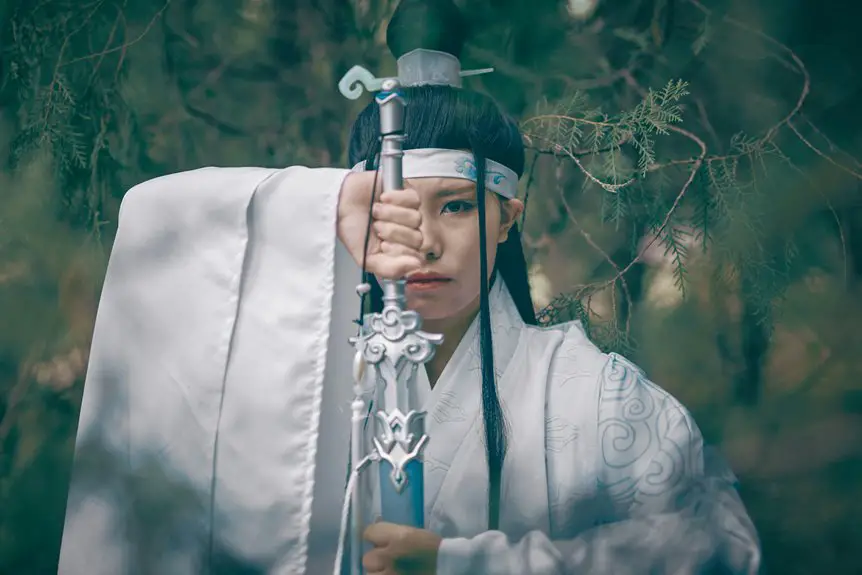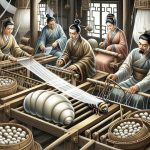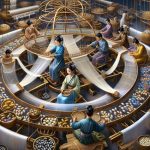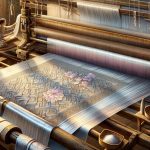The most highly prized fabric in ancient China was silk, cherished for its unmatched elegance and cultural significance. You’d find it worn by emperors and nobles, symbolizing wealth, spiritual protection, and social status. Silk production started over 4,000 years ago, involving a delicate process from cocoon harvesting to weaving fine threads. It fueled trade, transformed economies, and fostered cultural exchange along the Silk Road. If you want to discover how silk shaped history and fashion, there’s much more to uncover.
Table of Contents
Key Takeaways
- Silk was the most highly prized fabric in ancient China, symbolizing wealth, status, and spiritual significance.
- Empress Leizu is credited with discovering silk, linking it to royal and noble exclusivity.
- Silk production involved meticulous harvesting, boiling, and weaving processes to create fine, continuous threads.
- Silk trade along the Silk Road boosted ancient China’s economy and facilitated cultural exchanges with other civilizations.
- The legacy of silk endures in fashion, technology, and cultural symbolism, reflecting ancient Chinese sophistication.
Origins of Silk Production in Ancient China
Although the exact origins of silk production in ancient China remain a mystery, you can trace its beginnings back over 4,000 years.
You’ll find that silk was initially a closely guarded secret, known only to Chinese royalty and nobility. According to legend, Empress Leizu discovered silk when a cocoon accidentally fell into her tea, unraveling its fine threads. From that moment, you can imagine how silk quickly became a symbol of wealth and power.
Silk began as a secret treasure of Chinese royalty, discovered by Empress Leizu in a serendipitous moment.
As you explore ancient Chinese history, you’ll see silk weaving evolving into a sophisticated craft. You might be surprised to learn that silk’s exclusivity helped China control trade and influence neighboring regions long before the famous Silk Road emerged.
This fabric wasn’t just clothing—it was a cultural treasure.
The Silk-Making Process: From Cocoon to Cloth
You’ll start by harvesting the silkworm cocoons, carefully unraveling the delicate threads.
Then, you’ll spin these threads into fine silk yarns before weaving them into fabric.
Understanding these steps reveals how ancient Chinese artisans transformed raw materials into luxurious cloth.
Harvesting Silkworm Cocoons
The process of harvesting silkworm cocoons marks an important step in transforming raw silk into fabric. You carefully collect the delicate, oval-shaped cocoons once the silkworms have spun them fully. Timing is vital; you must harvest before the moth emerges to preserve the continuous silk thread. Handling each cocoon gently guarantees the fibers remain intact, ready for the next silk-making phase.
| Feeling | Action Taken | Result |
|---|---|---|
| Anticipation | Inspect cocoon quality | Select the best threads |
| Patience | Wait for proper timing | Secure strong silk fibers |
| Care | Handle cocoons gently | Prevent thread breakage |
| Pride | Sort and prepare | Ready for silk extraction |
| Satisfaction | Collect carefully | Begin silk’s transformation |
Spinning and Weaving Techniques
Once you’ve carefully gathered the silkworm cocoons, you move on to spinning and weaving, where raw silk transforms into fine fabric.
First, you boil the cocoons to soften the sericin, the natural gum holding the fibers together. Then, you gently unwind the long silk filaments, combining several strands to create a single thread strong enough for weaving. As you reel the silk, you maintain consistent tension to guarantee uniform thickness.
Next, you set up the loom, arranging the warp threads tightly. With practiced hands, you pass the weft thread through, weaving intricate patterns. This meticulous process demands patience and skill, as even slight errors affect the fabric’s quality.
Through spinning and weaving, you turn delicate silk into a luxurious cloth cherished throughout ancient China.
Silk’s Role in Ancient Chinese Society and Culture
Although silk originated thousands of years ago, its impact on ancient Chinese society and culture remains profound.
You’d find silk woven into the very fabric of daily life, symbolizing wealth, status, and spiritual significance.
When you explore its role, consider how silk:
- Marked social hierarchy, with emperors and nobles flaunting elaborate silk garments
- Played a part in religious rituals, symbolizing purity and divine favor
- Influenced art and literature, inspiring motifs and stories centered on silk’s elegance
- Served as a diplomatic gift, strengthening alliances and showcasing cultural sophistication
The Economic Impact of Silk Trade in Ancient Times
You can see how the Silk Road trade routes boosted economic growth and prosperity in ancient China by connecting distant regions.
Silk wasn’t just a luxury fabric; it became a key driver of cultural exchange and influence across continents.
Understanding this trade helps you grasp the broader impact silk had on shaping ancient economies and societies.
Silk Road Trade Routes
How did silk transform economies along the ancient trade routes?
As you explore the Silk Road, you’ll see how this precious fabric became a cornerstone of commerce. Silk wasn’t just a luxury; it was a powerful economic driver linking East and West. The trade routes enabled merchants like you to exchange goods, ideas, and culture, creating a vibrant network.
Consider these key aspects:
- Silk fostered demand across continents, boosting production and trade.
- Caravans carried silk alongside spices, precious metals, and ceramics.
- Trading hubs like Samarkand thrived due to silk commerce.
- Diplomatic relations often hinged on silk gifts and trade agreements.
Economic Growth and Prosperity
Because silk was in high demand, it sparked significant economic growth along the ancient trade routes. You’d see bustling markets flourish as merchants traded silk for spices, metals, and precious stones. This trade boosted wealth in cities and supported artisans, farmers, and traders alike. Silk production created jobs, from silkworm cultivation to weaving, stimulating local economies. Additionally, governments collected taxes and invested in infrastructure, enhancing trade efficiency. The silk trade became an economic backbone, connecting diverse regions and creating prosperity.
| Region | Economic Role | Key Benefit |
|---|---|---|
| China | Silk production | Job creation |
| Central Asia | Trade hubs | Wealth accumulation |
| India | Silk import and dyeing | Craft enhancement |
| Persia | Market expansion | Tax revenue |
| Rome | Luxury consumer | Demand stimulation |
Cultural Exchange and Influence
Although silk trade primarily drove economic growth, it also sparked profound cultural exchanges across ancient civilizations. You’d see how this prized fabric became a bridge connecting East and West, facilitating the flow of ideas, art, and technology.
As you explore the Silk Road’s influence, consider these key cultural impacts:
- Exchange of artistic motifs and techniques between China, Persia, and Rome
- Spread of religious beliefs, including Buddhism, through trade routes
- Introduction of silk production methods to new regions, enhancing local economies
- Cross-cultural culinary and fashion influences emerging along trading hubs
Silk Road: Connecting China With the World
The Silk Road served as an essential artery for trade, linking ancient China to distant lands and cultures.
When you envision this vast network, imagine caravans laden with silk traveling across deserts and mountains, reaching Central Asia, the Middle East, and even Europe. You’d find that silk wasn’t just a luxury fabric; it became a symbol of wealth and power far beyond China’s borders.
As you explore this route, notice how silk opened doors to cultural exchange, spreading ideas, religions, and technologies. You’d also see how demand for silk boosted China’s economy and fostered diplomatic ties.
Symbolism and Status Associated With Silk
As silk traveled along the Silk Road, it didn’t just carry goods—it carried meaning. When you wore silk in ancient China, you weren’t just dressed in fabric; you were embodying power and prestige.
Silk symbolized wealth, often reserved for the elite and royal families, marking your high social status unmistakably. Beyond its beauty, it represented:
- Authority, as emperors donned silk robes embroidered with dragons.
- Purity and elegance, reflected in the delicate texture and sheen.
- Spiritual protection, believed to ward off evil spirits.
- Connection to cultural identity and tradition, reinforcing your place in society.
In ancient China, silk was more than material—it was a statement you couldn’t ignore.
The Legacy of Ancient Chinese Silk in Modern Times
When you admire luxurious silk garments today, you’re witnessing a legacy that stretches back thousands of years to ancient China. Silk remains a symbol of elegance and refinement, influencing fashion, art, and culture worldwide.
You’ll notice how modern designers draw inspiration from traditional Chinese silk patterns and weaving techniques, blending heritage with innovation.
Beyond fashion, silk’s impact extends to technology and medicine, where its properties are studied and applied.
By choosing silk, you connect with a rich history of craftsmanship and cultural exchange that shaped global trade routes like the Silk Road.
This enduring fabric continues to embody the sophistication and creativity of ancient China, proving that its legacy is very much alive in the modern world you interact with daily.
Frequently Asked Questions
How Was Ancient Chinese Silk Preserved Over Centuries?
You’d think silk lasted forever, right? Well, they carefully stored it in cool, dry places, wrapped it in protective layers, and treated it gently to keep its shine and softness intact through centuries of history.
Were There Any Religious Rituals Linked to Silk Production?
You’ll find that ancient Chinese silk production involved religious rituals honoring silkworms and deities like Leizu. These rituals aimed to guarantee a good harvest and protect the delicate silk threads during harvesting and weaving.
What Were the Main Colors Used in Ancient Chinese Silk Dyeing?
Ever wondered why vibrant colors always captivate you? You’ll find ancient Chinese silk mainly dyed in rich reds, brilliant yellows, deep blues, and lush greens, each symbolizing prosperity, power, and harmony in their culture.
Did Ancient Chinese Silk Influence Textile Techniques Elsewhere?
You’ll find that ancient Chinese silk considerably influenced textile techniques abroad. Traders and travelers shared their weaving and dyeing methods, inspiring innovations in fabric production across Asia, the Middle East, and even Europe over time.
How Did Climate Affect Silk Cultivation in Ancient China?
You might think climate had little impact, but it actually shaped silk cultivation greatly. Warm, humid conditions helped mulberry trees thrive, feeding silkworms perfectly. So, the environment was essential to your silk production success.
- How to Set Your Tie-Dye so It Doesn’t Fade - July 13, 2025
- Safety Tips for Tie-Dyeing at Home - July 13, 2025
- The Best Tie-Dye Kits for Beginners - July 13, 2025







